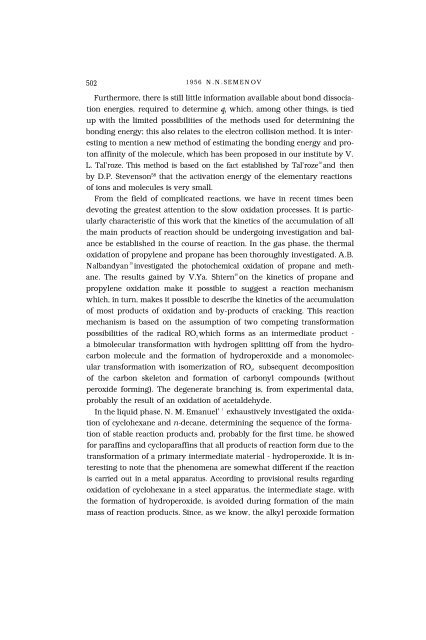Nikolai N. Semenov - Nobel Lecture - Nobelprize.org
Nikolai N. Semenov - Nobel Lecture - Nobelprize.org
Nikolai N. Semenov - Nobel Lecture - Nobelprize.org
Create successful ePaper yourself
Turn your PDF publications into a flip-book with our unique Google optimized e-Paper software.
502 1956 N.N.SEMENOV<br />
Furthermore, there is still little information available about bond dissociation<br />
energies, required to determine 2, which, among other things, is tied<br />
up with the limited possibilities of the methods used for determining the<br />
bonding energy; this also relates to the electron collision method. It is interesting<br />
to mention a new method of estimating the bonding energy and proton<br />
affinity of the molecule, which has been proposed in our institute by V.<br />
L. Tal’roze. This method is based on the fact established by Tal’roze 38 and then<br />
by D.P. Stevenson 58 that the activation energy of the elementary reactions<br />
of ions and molecules is very small.<br />
From the field of complicated reactions, we have in recent times been<br />
devoting the greatest attention to the slow oxidation processes. It is particularly<br />
characteristic of this work that the kinetics of the accumulation of all<br />
the main products of reaction should be undergoing investigation and balance<br />
be established in the course of reaction. In the gas phase, the thermal<br />
oxidation of propylene and propane has been thoroughly investigated. A.B.<br />
Nalbandyan 39 investigated the photochemical oxidation of propane and methane.<br />
The results gained by V.Ya. Shtern 40 on the kinetics of propane and<br />
propylene oxidation make it possible to suggest a reaction mechanism<br />
which, in turn, makes it possible to describe the kinetics of the accumulation<br />
of most products of oxidation and by-products of cracking. This reaction<br />
mechanism is based on the assumption of two competing transformation<br />
possibilities of the radical RO 2<br />
which forms as an intermediate product -<br />
a bimolecular transformation with hydrogen splitting off from the hydrocarbon<br />
molecule and the formation of hydroperoxide and a monomolecular<br />
transformation with isomerization of RO 2<br />
, subsequent decomposition<br />
of the carbon skeleton and formation of carbonyl compounds (without<br />
peroxide forming). The degenerate branching is, from experimental data,<br />
probably the result of an oxidation of acetaldehyde.<br />
In the liquid phase, N. M. Emanuel 4 1<br />
exhaustively investigated the oxidation<br />
of cyclohexane and n-decane, determining the sequence of the formation<br />
of stable reaction products and, probably for the first time, he showed<br />
for paraffins and cycloparaffins that all products of reaction form due to the<br />
transformation of a primary intermediate material - hydroperoxide. It is interesting<br />
to note that the phenomena are somewhat different if the reaction<br />
is carried out in a metal apparatus. According to provisional results regarding<br />
oxidation of cyclohexane in a steel apparatus, the intermediate stage, with<br />
the formation of hydroperoxide, is avoided during formation of the main<br />
mass of reaction products. Since, as we know, the alkyl peroxide formation
















